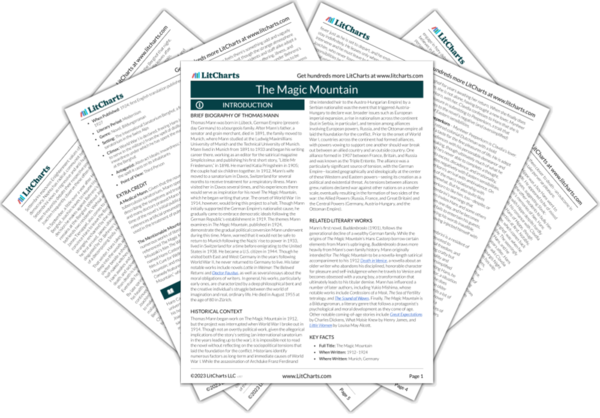Welcome to the LitCharts study guide on Thomas Mann's The Magic Mountain. Created by the original team behind SparkNotes, LitCharts are the world's best literature guides.
The Magic Mountain: Introduction
The Magic Mountain: Plot Summary
The Magic Mountain: Detailed Summary & Analysis
The Magic Mountain: Themes
The Magic Mountain: Quotes
The Magic Mountain: Characters
The Magic Mountain: Terms
The Magic Mountain: Symbols
The Magic Mountain: Theme Wheel
Brief Biography of Thomas Mann

Historical Context of The Magic Mountain
Other Books Related to The Magic Mountain
- Full Title: The Magic Mountain
- When Written: 1912–1924
- Where Written: Munich, Germany
- When Published: 1924; first English translation published 1927
- Literary Period: Modernism
- Genre: Novel, Bildungsroman
- Setting: The International Sanatorium Berghof, a fictional sanatorium in the Swiss Alps
- Climax: World War I is declared, freeing Hans (who will have to serve in the military) from the spell of disillusionment and inwardness under which he has spent the majority of his stay at the Berghof.
- Antagonist: Abstract Ideals; Inwardness; the Berghof and the spell it casts on its inhabitants
- Point of View: Third Person
Extra Credit for The Magic Mountain
A Medical Mann. Given that the novel takes place at a tuberculosis sanatorium, Mann spends considerable time describing the symptoms and treatments characters deal with, and many doctors praised Mann for his medical accuracy at the time of the novel’s initial publication. For instance, he references artificial pneumothorax, a newly developed method used in the treatment of pulmonary tuberculosis.
The Mentionable Mountain. Since its publication in 1924, numerous works of literature, music, and visual art have referenced The Magic Mountain directly or indirectly. Hayao Miyazaki’s film The Wind Rises (2013) features a character named Hans Castorp; Gore Verbinski’s psychological horror film A Cure for Wellness (2016) was inspired by The Magic Mountain; and musician Father John Misty’s 2017 album Pure Comedy features a song called “So I’m Growing Old on Magic Mountain,” which references Mann’s novel.












